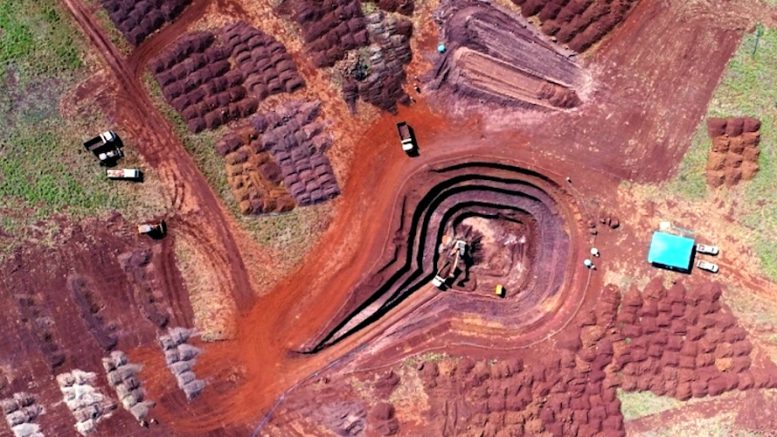With growing demand for battery metals including nickel, lithium and graphite, The Northern Miner has teamed up with our data provider Mining Intelligence to rank the top battery metals projects under construction globally, based on expected mine life.

Nickel
Starting with nickel, Horizonte Minerals’ (TSX: HZM; AIM: HZM) Araguaia project in northern Brazil boasts a mine life of 28 years, according to the most recent Dec. 2018 feasibility study. The US$586-million mine is nearing completion, with a production start scheduled for the first quarter of 2024. Araguaia is set to produce cobalt and iron ore as byproducts, which helps boost the open-pit operation’s after-tax net present value (NPV) to US$401 million. Araguaia, which Horizonte bought from Glencore (LSE: GLEN) in 2015, will initially generate 14,500 tonnes of nickel a year, mainly destined to supply the stainless steel market. Output is expected to jump to 29,000 tonnes a year after a second production line comes online in 2027.
The second longest-lived nickel project is West Musgrave in Australia, which was being advanced by Oz Minerals until the acquisition of the base metals miner by BHP (NYSE: BHP; LSE: BHP; ASX: BHP) in April. The polymetallic project, which will also produce copper, gold, silver, palladium and platinum, has an expected mine life of 21 years. A Sept. 2022 feasibility study pinned preproduction capital costs at A$2 billion ($1.8 billion), and its after-tax NPV at between A$1.5 and A$2 billion. West Musgrave is estimated to produce about 35,000 tonnes of nickel yearly in its first five years of production. The 13.5-million-tonne-a-year open pit mine is expected to produce concentrate for C1 costs of between negative-US$1.10 per lb. and US50¢ per lb. payable nickel. The project includes the Nebo and Babel nickel-copper deposits and the Succoth copper deposit.
Indonesian nickel deposits rank high in terms of mine life despite tending to use more carbon-intensive extraction methods. Jakarta-based PT Merdeka Copper Gold’s 51%-owned SCM-Sulawesi open pit mine. While data on the deposit is scarce, it has one of the biggest nickel resources in the world at 1.1 billion dry metric tonnes at 1.22% nickel for 13.8 million tonnes of nickel, so we’ve placed it at third on the list.
Data is also sparse for two Vale (NYSE: VALE) JV nickel developments in Indonesia. MI ranks the Pomalaa-PTVI and Bahodopi-Morowali projects, which respectively began construction last year and in February, tied at number four. Vale expects Pomalaa to produce 120,000 tonnes of nickel and 15,000 tonnes of cobalt annually contained in mixed hydrate precipitate products for EV batteries. MI places both projects as tied for third place in terms of mine life.
Australian nickel and lithium miner IGO (ASX: IGO) is next on the list with its Cosmos/Odysseus project in Australia. The A$381-million underground project has a 10-year mine life, according to a 2018 feasibility study.
Lithium
When it comes to lithium, the longest-lived mine in construction belongs to China’s top miner, Zijin Mining: the 3Q-Tres Quebradas project in Argentina. An October 2021 feasibility study outlined a 50-year mine plan and calculated an after-tax NPV of US$1.1 billion for the salt flat (salar) based project, following a total capital outlay of US$527 million.
Next, SQM (NYSE: SQM) and Wesfarmers (ASX: WES) are building the Mt Holland-Earl Grey Lithium open pit project, with a mine plan stretching 47 years, in Australia. A 2018 prefeasibility study concluded that for capital investment of US$737 million, the JV partners could expect a post-tax NPV of US$2.2 billion.
Three projects are tied in the third spot, each with a 40-year mine life. They include the Argentina-based Cauchari-Olaroz salar project under development by Ganfeng Lithium (46.7%), Lithium Americas’ (TSX: LAC; NYSE: LAC) (44.8%) and JEMSE (8.5%); Sal de Vida, under development by Allkem, and Thacker Pass being built by Lithium Americas in Nevada. A 2019 feasibility study calculated capital costs for Cauchari-Olaroz at US$565 million, and its post-tax NPV at US$1.3 billion. Sal de Vida costs are pegged at US$474 million to deliver an NPV of US$1.5 billion, according to a 2018 feasibility study, while Thacker Pass costs are estimated at US$5.5 billion for an NPV of US$5.7 billion.
Graphite
Africa leads the way in terms of long-lived graphite developments. According to Mining Intelligence data, Tirupati Graphite’s (LSE: TGR) US$126-million Montepeuz project in Mozambique has the longest life spanning 30 years. Construction of the project under a previous owner stopped at the start of the pandemic, and on Apr. 3, Tirupati became the owner, with construction activity expected to restart soon. A 2017 feasibility study calculated a post-tax NPV of US$146 million. The project is also likely to produce vanadium.
Ranking second is Triton Minerals’ (ASX: TON) Ancuabe project in Mozambique. While the company is still finalizing the construction schedule, the US$90-million project has an expected mine life of 27 years. A 2017 feasibility study calculated an NPV of US$298 million.
NextSource Materials (TSX: NEXT) has started commissioning its Molo graphite mine in Madagascar, which has an initial mine life of 26 years. The modular open pit project costs US$201 million, and a 2022 preliminary economic assessment calculated a post-tax NPV of US$593 million.
Nouveau Monde Graphite (TSXV: NOU; NYSE: NMG) is building the $1.5-billion Matawinie open pit project in Quebec. A 2022 feasibility study calculated an NPV of $1.9 billion over a 25-year mine life.
Rounding out our list is Australia’s Walkabout Resources (ASX: WKT), which is building the Lindi Jumbo project in Tanzania. A 2019 feasibility study pinned the project cost at US$29 million and calculated an NPV of US$197 million.


Be the first to comment on "RANKED: The world’s longest-lived battery metals mines under construction "